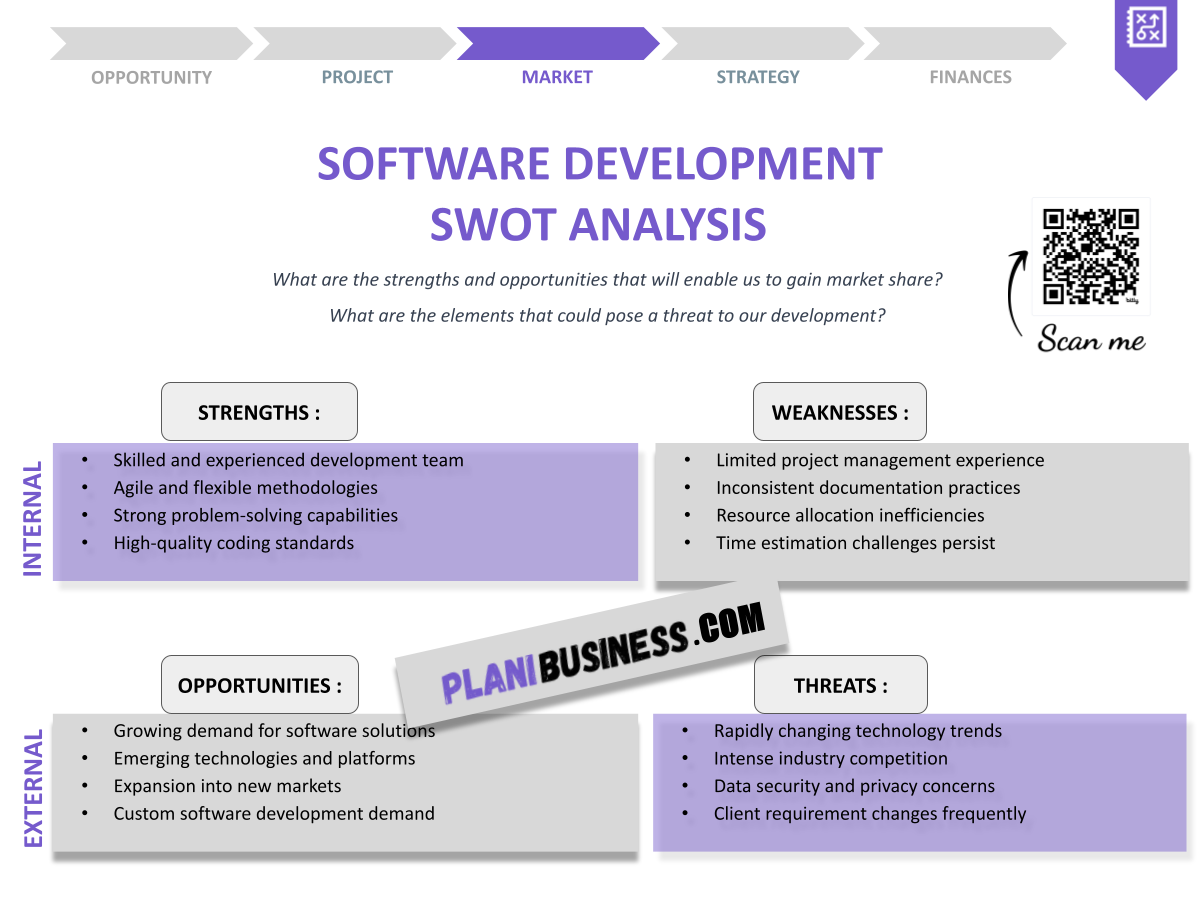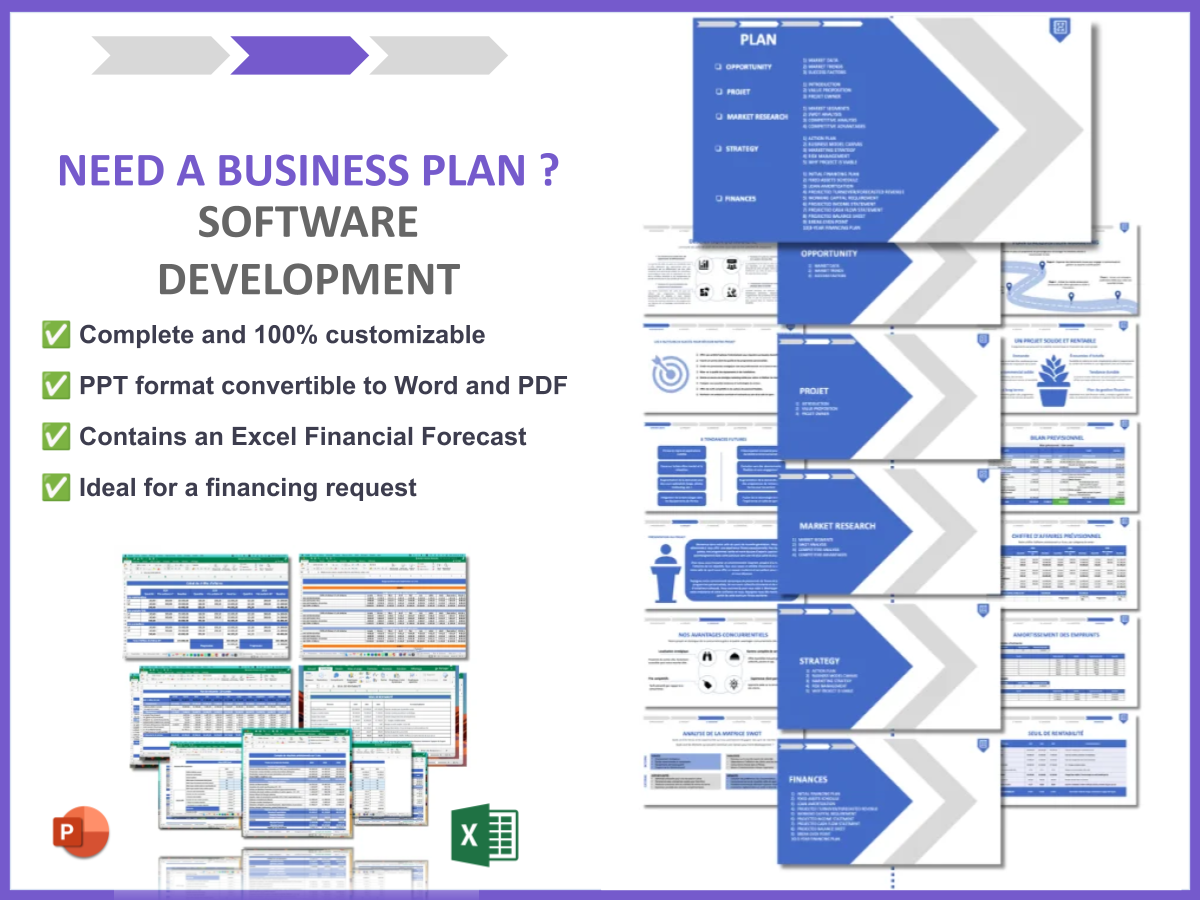Why Should You Have a SWOT Analysis for Software Development?
Did you know that nearly 70% of software projects fail due to poor planning? That’s a staggering statistic that highlights the critical need for effective strategic analysis. A SWOT analysis for software development is essential to identify your project’s strengths, weaknesses, opportunities, and threats, allowing you to navigate potential pitfalls. In a world where technology evolves rapidly, understanding these factors can make the difference between success and failure.
A SWOT analysis is a structured planning tool used to evaluate the internal and external factors that can affect a project’s success. By conducting a thorough analysis, you can gain insights that help shape your strategy and ensure that your software development project is on the right track.
- Understand your project’s strengths.
- Identify weaknesses before they become issues.
- Spot opportunities for innovation.
- Mitigate potential threats.
- Enhance team collaboration.
- Improve decision-making processes.
- Increase project success rates.
- Align project goals with market needs.
- Foster a proactive approach to challenges.
- Utilize insights for future projects.
How Do You Write a SWOT Analysis for Software Development?
Crafting a SWOT analysis is a straightforward yet impactful process. By breaking down each component, you can gain clarity on your software development project’s landscape.
Strengths
Strengths refer to the internal attributes that give your project an advantage over others. This could be your team’s expertise, unique technology, or strong partnerships. Identifying strengths can help in leveraging them effectively during project execution. Consider aspects like previous successful projects and customer loyalty as strengths to capitalize on. Documenting strengths sets a positive tone for the project and boosts team morale.
Weaknesses
Weaknesses are internal factors that could hinder your project’s success. These might include skill gaps or lack of resources. Acknowledging weaknesses is crucial for developing strategies to address them. Use honest assessments to identify areas needing improvement. Turning weaknesses into learning opportunities can lead to growth and innovation.
Opportunities
Opportunities are external factors that your project can exploit for growth. This could be emerging market trends or new technologies. Identifying opportunities allows you to pivot your strategy for maximum impact. Keeping an eye on competitors can help in recognizing potential opportunities. Seizing opportunities can significantly enhance your project’s market position.
Threats
Threats are external challenges that could jeopardize your project. These could be economic downturns or shifts in customer preferences. Understanding threats prepares you for potential risks. Regularly reviewing market conditions can help you stay ahead of potential threats. Developing contingency plans is essential to mitigate the impact of identified threats.
SWOT Example N°1 for Software Development
Let’s take a look at a real-world example of a software development company using a SWOT analysis. This example illustrates how identifying strengths, weaknesses, opportunities, and threats can significantly impact a project’s trajectory.
| SWOT | Analysis |
|---|---|
| Strengths | Strong team of developers with diverse skills. |
| Weaknesses | Limited marketing budget, affecting outreach. |
| Opportunities | Growing demand for mobile apps in various industries. |
| Threats | Increased competition from established players. |
- Innovative team with diverse capabilities.
- Marketing constraints limiting visibility.
- Potential for growth in mobile application market.
- Competitive landscape posing challenges.
- A strong team can lead to innovative solutions, but without marketing, those solutions may go unnoticed.
SWOT Example N°2 for Software Development
Here’s another example that illustrates the importance of a SWOT analysis. This scenario showcases how a different company navigated its challenges and opportunities.
| SWOT | Analysis |
|---|---|
| Strengths | Proprietary technology that sets them apart. |
| Weaknesses | High employee turnover leading to instability. |
| Opportunities | Partnerships with startups for collaborative projects. |
| Threats | Rapid technological changes requiring constant adaptation. |
- Unique technology offering a competitive edge.
- HR challenges impacting team dynamics.
- Collaboration opportunities with innovative startups.
- Technological risks due to fast-paced industry changes.
- Having proprietary technology is a significant advantage, but maintaining a stable team is essential for continuity.
SWOT Example N°3 for Software Development
Analyzing another case helps solidify the concept of a SWOT analysis. In this example, we explore how a software development firm successfully identified its internal and external factors.
| SWOT | Analysis |
|---|---|
| Strengths | Robust client base that provides consistent revenue. |
| Weaknesses | Slow response times to client inquiries. |
| Opportunities | Expanding into new markets with tailored solutions. |
| Threats | Regulatory changes affecting software compliance. |
- Established clients ensuring steady income.
- Response delays risking client satisfaction.
- Market expansion potential offering new revenue streams.
- Compliance risks due to changing regulations.
- A strong client base is great, but slow responses can lead to dissatisfaction and potential loss of business.
SWOT Example N°4 for Software Development
Let’s explore another scenario to gain further insights into how a SWOT analysis can guide decision-making in software development.
| SWOT | Analysis |
|---|---|
| Strengths | Experienced management team with a proven track record. |
| Weaknesses | Limited product offerings leading to market constraints. |
| Opportunities | Increased online presence through digital marketing. |
| Threats | Cybersecurity risks that could jeopardize client data. |
- Strong leadership fostering effective project management.
- Narrow product range limiting market reach.
- Growth potential through enhanced digital strategies.
- Security threats necessitating robust protective measures.
- An experienced team is invaluable, but a limited product range can restrict growth opportunities in a competitive market.
SWOT Example N°5 for Software Development
Here’s another relevant example to consider, illustrating how a SWOT analysis can be applied in a real-world scenario within the software development sector.
| SWOT | Analysis |
|---|---|
| Strengths | High employee satisfaction leading to low turnover. |
| Weaknesses | High project costs impacting profit margins. |
| Opportunities | Cloud computing growth creating new service offerings. |
| Threats | Increasing competition from emerging startups. |
- Positive workplace culture resulting in engaged employees.
- Cost pressures affecting overall profitability.
- Expanding market for cloud services providing new avenues for growth.
- Competitive threats from agile new entrants in the market.
- Happy employees often lead to better results, but high costs can limit project scalability and profitability.
SWOT Example N°6 for Software Development
Let’s dive into another case study that illustrates the value of conducting a SWOT analysis in software development.
| SWOT | Analysis |
|---|---|
| Strengths | Innovative solutions that address client needs effectively. |
| Weaknesses | Lack of documentation leading to knowledge gaps. |
| Opportunities | Global market reach with online platforms. |
| Threats | Intellectual property issues that could arise from competition. |
- Creative solutions enhancing client satisfaction.
- Documentation gaps risking project continuity.
- Potential for international expansion through digital channels.
- IP risks that could threaten proprietary technology.
- Innovation is key, but documentation is crucial for knowledge transfer and maintaining project integrity.
SWOT Example N°7 for Software Development
Another example to illustrate the process of conducting a SWOT analysis in a software development context can provide further clarity on how to leverage this tool effectively.
| SWOT | Analysis |
|---|---|
| Strengths | Diverse skill set among team members enhancing creativity. |
| Weaknesses | Poor time management affecting project timelines. |
| Opportunities | Collaboration with universities for research and development. |
| Threats | Talent shortages in the tech industry impacting hiring. |
- Versatile team capable of tackling various challenges.
- Time management issues leading to project delays.
- Partnerships with academic institutions for innovation.
- Hiring challenges due to high demand for skilled professionals.
- A diverse skill set can enhance creativity, but poor time management can lead to project delays and client dissatisfaction.
SWOT Example N°8 for Software Development
Continuing with more examples for a broader perspective, we can examine how another company utilized a SWOT analysis to inform its strategy in the software development arena.
| SWOT | Analysis |
|---|---|
| Strengths | Strong brand reputation within the industry. |
| Weaknesses | Operational inefficiencies leading to increased costs. |
| Opportunities | New market segments available for exploration. |
| Threats | Economic instability affecting client budgets. |
- Positive brand image attracting clients.
- Operational challenges affecting service delivery.
- Market opportunities presenting avenues for growth.
- Economic pressures impacting project funding.
- A strong brand can attract clients, but operational inefficiencies can undermine service quality and profitability.
SWOT Example N°9 for Software Development
Here’s yet another important case study showcasing the value of a SWOT analysis in the field of software development. This example emphasizes how different factors can influence project outcomes.
| SWOT | Analysis |
|---|---|
| Strengths | High employee satisfaction resulting in strong team cohesion. |
| Weaknesses | High project costs affecting budget allocations. |
| Opportunities | Cloud computing growth opening new service lines. |
| Threats | Increasing competition from both established firms and startups. |
- Engaged employees leading to better project outcomes.
- Budget constraints impacting project feasibility.
- Growth potential in the cloud services market.
- Competitive landscape posing challenges to market share.
- Happy employees often lead to better results, but high costs can limit project scalability and overall profitability.
SWOT Example N°10 for Software Development
Finally, let’s wrap it up with one last example that highlights the significance of conducting a SWOT analysis in software development.
| SWOT | Analysis |
|---|---|
| Strengths | Agile development methodology enhancing flexibility. |
| Weaknesses | Inconsistent quality control impacting product reliability. |
| Opportunities | Expansion into AI and machine learning applications. |
| Threats | Regulatory compliance issues that could lead to penalties. |
- Agile practices allowing for quick adjustments.
- Quality challenges risking customer satisfaction.
- New technologies offering avenues for innovation.
- Compliance risks that necessitate careful management.
- Agile methods enhance flexibility, but quality control is essential for maintaining standards and customer trust.
Conclusion and Final Thoughts
Conducting a SWOT analysis for software development is not just a formality; it’s a crucial step that can determine the success of your project. By identifying strengths, weaknesses, opportunities, and threats, you can create a roadmap that guides your decision-making and strategy. This proactive approach not only enhances your project’s chances of success but also empowers your team to tackle challenges effectively. If you’re looking to further enhance your planning, consider using a business plan template for software development that can provide you with a solid foundation.
Moreover, if you want to dive deeper into the world of software development, check out our articles on How to Build a Software Development Company? and How to Kickstart a Software Development Marketing Plan? With Example. These resources will provide you with valuable insights and strategies to ensure your project’s success!
FAQ Section
1. What is a SWOT analysis?
A SWOT analysis is a strategic tool used to assess strengths, weaknesses, opportunities, and threats related to a project or business, helping teams make informed decisions.
2. Why is conducting a SWOT analysis important for software development?
It allows teams to identify critical internal and external factors that can impact project success, leading to improved planning and execution.
3. How often should a SWOT analysis be updated?
Regular updates are essential, especially before significant project phases or when there are notable changes in the market or technology.
4. Can a SWOT analysis change over time?
Yes, as your project evolves and market conditions shift, the elements of a SWOT analysis may need to be revised to remain relevant.
5. Who should participate in a SWOT analysis?
Involving team members from various departments can provide diverse perspectives, leading to a more comprehensive analysis.
6. What are common pitfalls in conducting a SWOT analysis?
Some common pitfalls include not being honest about weaknesses, failing to update the analysis regularly, and not involving enough stakeholders.
7. How detailed should a SWOT analysis be?
It should provide enough detail to yield actionable insights while remaining concise and easily understandable for all team members.
8. What tools can assist in creating a SWOT analysis?
Utilizing templates, mind mapping software, or collaborative platforms can help streamline the process and enhance clarity.
9. How can a SWOT analysis influence a project’s strategy?
It provides a clear understanding of the project landscape, allowing teams to make informed adjustments to their strategies based on identified factors.
10. What should be done after completing a SWOT analysis?
Use the insights gained to develop a strategic plan, set priorities, and allocate resources effectively for project success.







